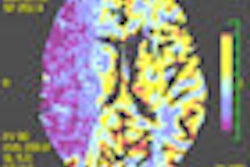
Efficient use of teleradiology, along with efforts to control imaging demand, will play a central role in reducing future radiology workload, according to a senior Turkish radiologist who is speaking at this week's Management in Radiology (MIR) scientific meeting in Milan.
Professional burnout is one of the hot topics being discussed at the MIR congress. Among the emerging trends that are likely to have an impact are radiographers being trained to interpret x-rays and all ultrasound exams falling within the sole remit of the sonographer, but overall new imaging techniques and technology will inevitably multiply work volumes for all staff, said Dr. Oğuz Dicle, chairman of the department of radiology at "9 September University" School of Medicine, Izmir, Turkey.
 As a PACS user for 12 years, Dr. Oğuz Dicle hasn't observed any positive effect of PACS in terms of lowering the workload.
As a PACS user for 12 years, Dr. Oğuz Dicle hasn't observed any positive effect of PACS in terms of lowering the workload.
In advance of today's workload session at the MIR congress, Dicle outlined the challenges facing medicine and radiology, the changing role of the radiologist, the factors affecting workload and quality, as well as the future outlook for radiologists in terms of workload.
Imaging for screening and follow-up has increased the number of examinations in medical practice, and diagnostic and treatment guidelines have also contributed to heavier workloads, he explained. In addition, changing health policies that promote imaging as a means to curb long-term medical costs across the population have been accompanied by falling reimbursement for imaging in tandem with a move toward privatization.
"One of the most important challenges today is the increasing -- and aging -- world population. The proportion of people over 80 will increase rapidly after 2020, according to many research papers," Dicle told AuntMinnieEurope.com ahead of today's MIR presentation, noting that the aging population demands high-quality healthcare systems.
In a context of limited finances and manpower, classical medicine has become a technology-dependent business: Radiology thus faces many challenges, in part due to changing economics and globalization, and because of the increasing complexity of the specialty because of evolving technology. While the workload swells, there is less time available per patient and for academic pursuits because the number of radiologists does not increase proportionally.
"The cost of new installations rises, while healthcare and research budgets shrink," Dicle noted. "Technology-dependent medicine is dividing our specialty. Turf battles waste our energy."
Few papers about trends in workload have been published to date, he said. Most recently, in a paper concerning burnout and satisfaction of U.S. physicians, radiologists were ranked ninth among 18 specialties, with more than 50% of the 7,288 radiologists who completed their surveys declaring that they experienced burnout due to responsibilities and workload (Archives of Internal Medicine, October 2012, Vol.172:18, pp.1-9).
Other research has found that radiological procedures per full-time equivalent (FTE) radiologist per year increased to 14,900 in 2007 from 13,950 in 2003, while a 2011 Medicare report for the U.S. Congress revealed that imaging was the highest physician service per beneficiary due to diagnostic tests, and the main burden on and cost to the health system. Additional research shows that between the years 2000 and 2005, brain MRI doubled while x-ray examinations fell.
This means that not only the number of procedures but also the complexity and difficulty of imaging have increased gradually, according to Dicle. Because of the different types of radiological positions and duties, crude study numbers do not reflect the real workload. Relative value scales do exist to allow comparison of different procedures on the basis of time expended, complexity of the examination, or both. However most of these scales have been developed for reimbursement processes and don't take into consideration nonreporting activities.
"Most of our colleagues work as consultant radiologists in daily practice, or in academic positions. However, none of them are identical. The evaluation of workload details such as the type of work done and the configuration and complexity of responsibilities, must be factored in as well as the amount of time spent on each type of task," he stated.
Intrinsic factors affecting workload and quality include how many radiologists are sharing the workload, how many hours a radiologist works per day or week, how many examinations are reported per day, the combination of the exams reported, the methods used for displaying the images, dictation and typing, and the kind of nonreporting duties the radiologist fulfills.
The distribution of radiologists in different countries varies starkly. The EU average is 110 per million population. Greece comes in at the top with 228, while Japan has the lowest distribution with 40 radiologists per million population. Likewise, the number of radiological examinations per million population per day also varies between countries, and for MRI ranges from 20 in Australia to 90 in the U.S.
"In terms of working hours, national laws make for little discrepancies among the countries. However, in practice most of us work over these limits," Dicle said, adding that the European standard is 40 hours per week, but under Turkish law radiologists may work 35 hours per week. However, according to the literature, a U.S. radiologist works 49.3 hours weekly. Radiologists working alone may work up to 50.3 hours, while a private radiologist works an average 50.4 hour per week.
Evaluations of the PACS' impact on workload differ widely. In most papers, authors have concluded that the transition to filmless operations was associated with increases in inpatient and outpatient use of radiological services. A number of the articles have claimed that PACS improved reporting times and productivity, while others suggested that the introduction of PACS/RIS facilities increased the time required to report each examination, in some cases by 20%.
"I am a PACS user for 12 years, and in my experience PACS disciplines the work flow, increases productivity and reporting quality, and enhances educational motivation. However, I haven't observed any positive effect of PACS in terms of lowering the workload of the department," Dicle said, pointing to 1,200 or so examinations performed daily in the hospital's radiology service. "Teleradiology brings with it new challenges. Centers using teleradiology to compensate for the shortage in radiologist numbers may see workload lessen. However, for the centers on the receiving end, working hours will be expanded."
To compensate for increasing workload, radiologists have to operate rapidly. Heavier workloads not only encourage the use of speed but also the resulting fatigue of increased work volume itself might blunt perception skills, even if appropriate time is used per case.
"It has been reported that interpreting more than 20 abdominal CT scans per day doubles the error rate. There is no scientific data proving that 3D interpretation improves speed and quality in reporting," he said.
Dicle explained that the Turkish health system transformation aims to increase access to the system, centralize insurance bodies, give total coverage of the population, and promote private health services.
"Payment is now made according to performance: The more images a physician requests, the more they may gain. For a radiologist, earnings are directly correlated to the number of reports made. The transformation was completed within a 10-year period and as a result the volume of radiological imaging increased tremendously while imaging prices went down," he said.
Overall, Turkish radiologists' incomes have risen a little, but because workload has increased significantly, acquisition and reporting quality diminished. As a case in point, the number of MRI examinations per 100 patients was 0.4 before the transition, jumping to 1.9 afterward.
"The positive change in income seems good. But the effort that radiologists have to make now is excessively more than before and not comparable with their earnings," Dicle clarified. "To keep the workload and quality constant, you have to limit the number of procedures and share the work volume with departmental colleagues."



















